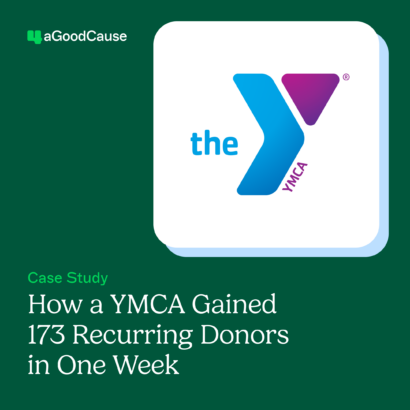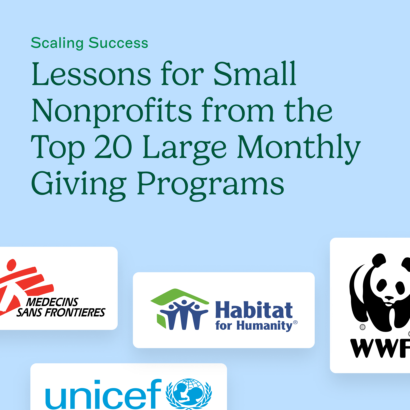Sometimes, all we need is a little inspiration and insight into what others are doing to kick-start our creative juices or give ourselves the boost to say, “Hey! We can do something like that, too.” Here at 4aGoodCause, we have a handful of community foundation clients that are doing some amazing things with relief funds during the coronavirus pandemic. And community foundations are just the right entities to do these things—because they exist to support the local communities. In an effort to highlight their good work and provide ideas and inspiration to all of our readers, we have highlighted six community foundations as a way to inspire you. You’ve got this.
Community Foundation for Northeast Georgia
Website | Twitter | Facebook | LinkedIn
The Coronavirus Relief Fund established by the Community Foundation for Northeast Georgia (CFNEG) has reached over $600,000 (of a $1 million goal). CFNEG is using Twitter to post daily updates on how to give, how much they have been able to distribute so far and provide free webinars for learning how nonprofits can market while social distancing. “We opened the fund on Friday, March 13, after a series of community leadership meetings that clearly showed us the challenges ahead. We were the first Community Foundation in the state of Georgia to create a fund for COVID-19. [The Fund] was up and running and being communicated within 24 hours,” said Randy Redner, CEO at CFNG.
Providing the extras
Though the foundation has a lot of information on its website, it is tapping into its audience on Twitter to keep CTAs (calls to action) in place and daily updates going to reach its followers and disseminate information in multiple ways. “We have been using social media, email but also mainstream media in terms of newspaper, radio and TV. We have also been very proactive to get it into other networks like the school system, county government, chamber, etc.,” said Randy.
How you can emulate
Use the channels outside of your website (Twitter, Facebook, Instagram) to share your stories in real-time and provide daily updates to your communities. In addition, Randy suggests, “Learn how to use Zoom! Key in these times is to get laser-focused on the two or three things you and your team can do and go to work at that. Also, dial up the listening skills and link into as much as you can so you can see the picture develop and then connect to the right resources that will accelerate the two or three things you are focused on.”
Crown Point Community Foundation
Responding to the coronavirus pandemic affecting those in South Lake County, Crown Point Community Foundation set up its CPCF CARE-Emergency Aid & Relief Fund. The foundation does a great job of providing two options right up front on its home page—how to give to the new fund or, if you’re a nonprofit requesting aid, how to apply for a grant distributed from this new fund.
Communication that worked
CPCF highlighted two things on its relief fund page: first, that 100% of donations to the fund will be used to provide direct support to nonprofit organizations and second, that as a foundation, they have also allocated $30,000 to support these efforts.
How you can replicate
Be clear about where your money, donations or services go. And, if you are contributing additional funds to the cause, highlight that. Even if you are doing things such as scaling back budgets, moving money out of operating to other funds or being creative with staff resources, your donors and recipients like to hear about these changes. It puts humanity into what you are doing.
Community Foundation of the Ozarks
Website | Twitter | Facebook | Instagram
In addition to its COVID-19 Response & Recovery Fund, the Community Foundation of the Ozarks has partnered with other nonprofit agencies as a sort of “Philanthropy Row” in order to work together, assess needs and identify collaborative solutions. As told to us by Louise Knauer, COO of the foundation, “After the first of the year, I started thinking about our disaster response planning and starting an update of our internal COOP plan as well as considering whether this type of situation would fit our framework. Traditionally, our disaster response has focused on natural disasters and we use guidance such as whether there is a state or federal disaster declaration; whether victims are vulnerable populations, etc.
I actually began to research whether Coronavirus is considered a natural or human-made disaster and it appears the answer is somewhere in between. On March 12, I attended a community leadership breakfast on behalf of our president, who was traveling. It included a report from our county health director. It became apparent that this was evolving into uncharted territory, but clearly the circumstances would trigger the need for a philanthropic response.”
Why this works
Strength in numbers is what we need in times of uncertainty. CFO has done this by collaborating with others as a way to spread the messaging wide and tap into additional resources and professionals working collaboratively to deliver solutions to those in need. As Louise tells us, “We’ve worked closely with the Missouri Foundation for Health, which is providing extensive grantmaking support across its service area in Missouri. The other major seed gift was from the Louis L. and Julia Dorothy Coover Charitable Foundation, managed by Commerce Trust; we have administered their grantmaking program since the 1990s.
Of course, our staff has worked through the many moving parts from the donation portal via 4aGoodCause to the grantmaking process, working with donors, etc. We also have had several related funds open as well, such as corporate benevolence for companies to assist employees; or field-of-interest funds to support furloughed workers such as the hospitality industry.”
Ideas to try
Start building relationships with other like-valued nonprofits and organizations in your community. Establish quarterly check-ins with one another to stay on each other’s radar and think about what the plan could be going forward if an emergency arises. By establishing these relationships ahead of time, you’re more apt to be able to lean on one another in times of need. As Louise recommends, “Connect with your community’s leadership to make sure you have the best possible understanding of your local needs and issues. For instance, we are receiving a huge number of applications related to food programs and pantries. But there is a lot of government support happening in this area.
We are actually using our region’s food bank distribution center to help us screen these applications. Our president is on every call of the community leadership network to intimately understand not only what is happening today, but what is coming in the next days and weeks.” Louise also suggests convening your major funders to “make sure you’re not duplicating efforts so every sorely needed dollar will stretch as far as possible”. As she suggests, “It’s never too late to soften the ground for the next disaster by maintaining these connections and awareness regarding your role in disaster philanthropy when we get to the other side of this.”
Community Foundation of South Jersey
Website | Twitter | Facebook | LinkedIn
The COVID-19 Fund established by the Community Foundation of South Jersey points out that it’s working to resolve both short-term and long-term economic issues relative to the pandemic. The organization provides information on both ways to apply for the grant and ways to give as a sort of one-stop-shop of information.
A different giving page
At the bottom of its South Jersey COVID-19 Response Fund page, CFSJ provides a shortlist of nonprofit resources, including additional assistance programs and links to information provided directly from the state of New Jersey.
Why this is OK
In times of crisis, sometimes we need to break the mold. Typically, we want giving pages to have limited buttons and calls to action. However, in a time where everyone is grasping for more information, more support and more details, your audience may appreciate additional resources outside of the typical donation button. Provide value and show how donations will help support others during this trying time.
Stonewall Community Foundation
Website | Twitter | Facebook | Instagram
Stonewall exists to mobilize resources for the LGBTQ community in New York. The foundation’s Emergency Response Fund was founded in the wake of Hurricane Sandy and is a tool they are relying on during this time to continue to support the LGBTQ community. By surveying the grantee partners to learn about the challenges they were facing as coronavirus reached pandemic levels, Stonewall was able to provide $20k in grants to address present community needs. This included grants for administrative telework and specialized sanitation, grants for virtual services at LGBTQ senior centers and for mobile meals for the homeless.
“As soon as we heard the news of the COVID-19 outbreak, we knew that, for numerous reasons, members of the LGBTQ community would be particularly vulnerable. When social distancing orders came down, it became clear that the nonprofits that many in our community rely on for vital programs and services would experience unprecedented challenges. That’s when we got our Emergency Response Fund prepared to meet emerging community needs,” stated Gattlin Miller, communications and engagement manager at Stonewall.
How they were able to act quickly
Because the foundation’s Emergency Response Fund was already in place, they were able to pivot, using that fund to support needs that have become apparent during COVID-19. As Gattlin mentioned, “We knew that in order to respond effectively to community needs, we would first need to hear from our community. We surveyed our wide network of grantees to determine their most pressing needs and moved forward accordingly. Within a week, we had a plan of action in place based on their feedback. Our priorities included releasing restrictions on previously awarded grants, providing capacity grants for admin telework and specialized sanitation services, and program expansion grants that would allow groups to provide services virtually.”
How to use this tactic
Plan ahead for what could come. Though you may not have something in place now, think about how you can create restricted giving funds or programs that have the ability to pivot when a crisis arises. By having a plan documented, you’ll be able to respond quicker than if you needed to come up with the plan in the first place. And as Stonewall did, don’t be afraid to ask your network and community. “Our network of community partners were the key players in making this happen,” mentioned Gattlin. “In everything we do at Stonewall, we keep our grantees at the center. So, getting community feedback from these stakeholders was vital in informing our response strategy.”
The Community Foundation Martin—St. Lucie
Website | Twitter | Facebook | LinkedIn
The Community Foundation Martin – St. Lucie’s COVID-19 Response Fund awards grants to non-profits that serve the communities’ most vulnerable populations that are stressed by the outbreak (within the Treasure Coast area). A portion of the Fund will also be used to provide critical financial assistance to qualified economically disadvantaged individuals and families. As the foundation collects donations to this fund, it has implemented a $50 minimum donation for credit card gifts. According to the website, resources for processing smaller donations are limited which is why they are requiring a $50 minimum on credit card donations.
Why this works
The foundation is being upfront with a list of FAQs right on its donation page. This makes it easy for donors to understand processes, where the money is going and understand that they, too, have limited resources during this time.
What you can learn
Transparency is key and appreciated. Be upfront with your donors and those who benefit from your services. They will understand that everyone is working with limitations during this time. If it costs you more to process funds under a certain amount, don’t be afraid to set limits on credit card donations or provide other ways to give as The Community Foundation Martin—St. Lucie did.



